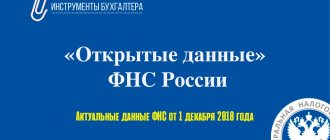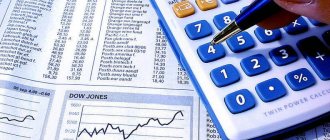OS adoption
Example
Zoo-land LLC sells reptiles, fish and equipment for them through a stationary store. In April 2020, the organization purchased equipment:
- An aquarium for keeping fish in a store, costing 52,530 rubles. including VAT.
- A terrarium for keeping reptiles in a store, worth RUB 252,360. including VAT.
- An aquarium intended for resale, worth RUB 48,490. including VAT.
- Exhibition rack, costing 41,640 rubles. including VAT.
The following fees were paid for installation: for the terrarium - 12,710 rubles. including VAT, for an aquarium – 5,280 rubles. including VAT.
Whether the purchased equipment belongs to the OS is determined based on 5 criteria of our PBU:
| Criteria for classification as OS | PBU 6/01 | Aquarium for keeping fish | Terrarium for keeping reptiles | Aquarium for resale | Exhibition rack | |
| 1 | Designed for use in business activities | subp. and point 4 | Yes | Yes | Yes | Yes |
| 2 | Designed for long-term use (over 1 year) | subp. b paragraph 4 | Yes | Yes | Yes | Yes |
| 3 | Not applicable as goods for resale | subp. in paragraph 4 | Yes | Yes | No | Yes |
| 4 | Designed to benefit | subp. g p. 4 | Yes | Yes | Yes | Yes |
| Cost upon acceptance for accounting | p. 7-8 | RUB 48,175 = (52 530 + 5 280) : 120 * 100 | RUB 220,892 = (252 360 + 12 710) : 120 * 100 | RUB 40,408 = 48 490 : 120 * 100 | RUB 34,700 = 41 640 : 120 * 100 | |
| 5 | Compliance with the limit on the value of fixed assets for acceptance in accounting | para. 4 p. 5 | Yes | Yes | Yes | No |
| Acceptance in accounting as OS | TOTAL | Yes | Yes | No, accepted as goods for resale | accepted either as OS or as inventory (at the organization’s choice) | |
IMPORTANT! The limit on the cost of fixed assets for acceptance in tax accounting (TA) is 100,000 rubles (clause 1 of article 256 of the Tax Code of the Russian Federation and clause 1 of article 257 of the Tax Code of the Russian Federation). The maximum cost of fixed assets in accounting still remains at the same level: 40,000 rubles.
For fixed assets registered from the beginning of 2020 at an original cost of more than 40,000 to 100,000 rubles, income tax payers have to take into account temporary differences between expenses in tax and accounting.
For an example of how to account for temporary differences, see here.
In our example, only the terrarium is accepted as a depreciable fixed asset in the NU. An aquarium for fish, accepted in accounting (BU) as an OS, is reflected in the NU as part of material costs (subsection 3, clause 1, article 254 of the Tax Code of the Russian Federation).
Case Study
In conclusion, let's look at a practical example of calculating depreciation and reflecting differences that arise in accordance with PBU 18/02. It was when solving this problem that some competitors made mistakes.
Situation
On July 11, 2016, Bereg JSC, for production activities, purchased a used production machine from Horizon LLC at a cost of RUB 3,500,000, including 18% VAT. JSC Bereg transferred the funds for the machine to the seller in full in September 2020. The fixed assets facility was put into operation in July 2020. JSC "Bereg" determined the useful life - 10 years 1 month (121 months) in tax accounting, in accounting - 8 years (96 months). Having received documents confirming the useful life from the seller of the production machine, Bereg JSC concluded that the seller operated the fixed asset for 21 months. The accountant of Bereg JSC, having established the useful life in tax accounting, adjusted it to the period of use of the machine at Horizont LLC.
In tax accounting, when calculating depreciation, Bereg JSC applies a depreciation premium and writes off 30% of the cost of the fixed asset at a time.
According to the accounting policy, Bereg JSC calculates depreciation using the straight-line method (method) in both accounting and tax accounting.
JSC Bereg continued to operate the machine until the end of its useful life (both accounting and tax).
Exercise
- Indicate which document can be used to confirm the service life of a fixed asset item at Horizont LLC.
- Calculate depreciation in tax accounting. When and in what amount can Bereg JSC recognize income tax expenses associated with the acquisition of fixed assets (including calculated depreciation)?
- Place the purchased fixed asset item on the books.
- Can Bereg JSC apply a depreciation premium when calculating depreciation in accounting? If yes, then apply it when calculating depreciation. Calculate depreciation in accounting.
- Will an accountant need to use PBU 18/02? If yes, then indicate what entries and when will be made in the accounting records and in what amount in connection with the application of this PBU for the entire period of operation at JSC Bereg.
Depreciation of fixed assets
According to PBU 6/01 “Accounting for Fixed Assets,” the useful life (abbreviated as SPI) of property is established by organizations based on the planned period of use, depreciation and other time restrictions on the use of fixed assets (clause 20 of PBU). There is no clear division of objects by SPI. To bring together the procedure for reflecting depreciation costs in accounting records with NU, organizations use the Classification of fixed assets by depreciation groups, approved by Decree of the Government of the Russian Federation dated January 1, 2002 No. 1. The use of this classification when establishing SPI is reflected in paragraph 1 of Art. 258 Tax Code of the Russian Federation.
Example (continued)
Aquariums and terrariums purchased by Zoo-land LLC, according to the OS Classification, belong to depreciation group 6 (SPI 10 - 15 years).
When reflecting on April 18, 2020 in the BU of the fish aquarium and terrarium as the OS, the company entered the SPI: 132 months for the aquarium and 144 months for the terrarium.
The accounting policy of Zoo-land LLC establishes a linear method for determining the depreciation of fixed assets.
The monthly amount of fixed assets depreciation was:
Aquarium for keeping fish: RUB 48,175. : 132 months = 365 rub.
Terrarium for keeping reptiles: RUB 220,892. : 144 months = 1,534 rub.
The calculated depreciation for the aquarium and terrarium is reflected in the accounting system from May (from the month following the month they were taken into account) (clause 21 of the PBU).
In clause 18 of the PBU under consideration, 4 methods of determining depreciation are recorded:
- Linear.
Simplest. The calculation algorithm specified in clause 19 of the PBU coincides with the linear method of calculating depreciation, enshrined in Art. 259.1 of the Tax Code of the Russian Federation, which makes it possible to bring closer the NU and BU of depreciation costs. Used by most organizations.
Details are in the article “Linear method of calculating depreciation of fixed assets (example, formula).”
- Reducing balance.
Complex calculation algorithm. There is no equivalent method of depreciation enshrined in the Tax Code of the Russian Federation, therefore additional difficulties arise in the form of reflecting temporary differences between NU and BU depreciation costs. Designed for accelerated write-off of the cost of the operating system. The use of this method is advisable for equipment that quickly becomes obsolete in moral terms.
Read about the features of this method in the article “Formula and example of the reducing balance of depreciation.”
- Based on the sum of the numbers of SPI years.
A labor-intensive technique in calculus. There is no equivalent depreciation method approved in the Tax Code of the Russian Federation, therefore its use leads to the emergence of temporary differences between the NU and BU depreciation. Refers to accelerated methods of depreciation of fixed assets.
For more information on this method of depreciation, see the article “How to correctly apply the cumulative depreciation method?”
- Proportional to the volume of production (work).
Labor-intensive to calculate. There is no equivalent method for calculating depreciation in the Tax Code of the Russian Federation, which leads to differences between the NU and BU depreciation charges. Designed for operating systems for which the planned amount of work for the entire useful life period is known. Used in relation to industrial equipment and transport.
Accounting Regulations
“Accounting for fixed assets” PBU 6/01
I. General provisions
1. These Regulations establish the rules for the formation in accounting of information about the organization’s fixed assets.
An organization is further understood as a legal entity under the laws of the Russian Federation (with the exception of credit organizations and state (municipal) institutions). 2. Excluded starting from reporting for 2006.
3. This Regulation does not apply to:
machines, equipment and other similar items listed as finished products in the warehouses of manufacturing organizations, as goods - in the warehouses of organizations engaged in trading activities;
items handed over for installation or to be installed that are in transit;
capital and financial investments.
4. An asset is accepted by an organization for accounting as fixed assets if the following conditions are simultaneously met:
a) the object is intended for use in the production of products, when performing work or providing services, for the management needs of the organization, or to be provided by the organization for a fee for temporary possession and use or for temporary use;
b) the object is intended to be used for a long time, i.e. a period lasting more than 12 months or the normal operating cycle if it exceeds 12 months;
c) the organization does not intend the subsequent resale of this object;
d) the object is capable of bringing economic benefits (income) to the organization in the future.
A non-profit organization accepts an object for accounting as fixed assets if it is intended for use in activities aimed at achieving the goals of creating this non-profit organization (including in business activities carried out in accordance with the legislation of the Russian Federation), for management needs non-profit organization, as well as if the conditions established in subparagraphs “b” and “c” of this paragraph are met.
The useful life is the period during which the use of an item of fixed assets brings economic benefits (income) to the organization. For certain groups of fixed assets, the useful life is determined based on the quantity of products (volume of work in physical terms) expected to be received as a result of the use of this object.
5. Fixed assets include: buildings, structures, working and power machines and equipment, measuring and control instruments and devices, computer equipment, vehicles, tools, production and household equipment and accessories, working, productive and breeding livestock, perennial plantings, on-farm roads and other relevant facilities.
The following are also taken into account as part of fixed assets: capital investments for radical improvement of land (drainage, irrigation and other reclamation works); capital investments in leased fixed assets; land plots, environmental management objects (water, subsoil and other natural resources).
Fixed assets intended exclusively for provision by an organization for a fee for temporary possession and use or for temporary use for the purpose of generating income are reflected in accounting and financial statements as part of profitable investments in tangible assets.
Assets in respect of which the conditions provided for in paragraph 4 of these Regulations are met, and with a value within the limit established in the organization’s accounting policy, but not more than 40,000 rubles per unit, may be reflected in accounting and financial statements as part of inventories . In order to ensure the safety of these objects in production or during operation, the organization must organize proper control over their movement.
6. The accounting unit for fixed assets is an inventory item. An inventory item of fixed assets is an object with all its fixtures and accessories, or a separate structurally isolated item intended to perform certain independent functions, or a separate complex of structurally articulated items that constitute a single whole and are intended to perform a specific job. A complex of structurally articulated objects is one or more objects of the same or different purposes, having common devices and accessories, common control, mounted on the same foundation, as a result of which each object included in the complex can perform its functions only as part of the complex, and not independently.
If one object has several parts, the useful lives of which differ significantly, each such part is accounted for as an independent inventory item.
An item of fixed assets owned by two or more organizations is reflected by each organization as part of fixed assets in proportion to its share in the common property.
II. Valuation of fixed assets
7. Fixed assets are accepted for accounting at their original cost.
8. The initial cost of fixed assets acquired for a fee is recognized as the amount of the organization’s actual costs for acquisition, construction and production, with the exception of value added tax and other refundable taxes (except for cases provided for by the legislation of the Russian Federation).
The actual costs for the acquisition, construction and production of fixed assets are:
amounts paid in accordance with the contract to the supplier (seller), as well as amounts paid for delivering the object and bringing it into a condition suitable for use;
amounts paid to organizations for carrying out work under construction contracts and other contracts;
amounts paid to organizations for information and consulting services related to the acquisition of fixed assets;
customs duties and customs fees;
non-refundable taxes, state duties paid in connection with the acquisition of fixed assets;
remunerations paid to the intermediary organization through which the fixed asset was acquired;
other costs directly related to the acquisition, construction and production of fixed assets.
General and other similar expenses are not included in the actual costs of acquisition, construction or production of fixed assets, except when they are directly related to the acquisition, construction or production of fixed assets.
9. The initial cost of fixed assets contributed to the contribution to the authorized (share) capital of the organization is recognized as their monetary value, agreed upon by the founders (participants) of the organization, unless otherwise provided by the legislation of the Russian Federation.
10. The initial cost of fixed assets received by an organization under a gift agreement (free of charge) is recognized as their current market value on the date of acceptance for accounting as investments in non-current assets.
11. The initial cost of fixed assets received under contracts providing for the fulfillment of obligations (payment) in non-monetary means is recognized as the value of the assets transferred or to be transferred by the organization. The value of assets transferred or to be transferred by an organization is established based on the price at which, in comparable circumstances, the organization usually determines the value of similar assets.
If it is impossible to determine the value of assets transferred or to be transferred by the organization, the value of fixed assets received by the organization under contracts providing for the fulfillment of obligations (payment) in non-monetary means is determined based on the cost at which similar fixed assets are acquired in comparable circumstances.
12. The initial cost of fixed assets accepted for accounting in accordance with clauses 9, 10 and 11 is determined in relation to the procedure given in clause 8 of these Regulations.
13. Capital investments in perennial plantings and for radical land improvement are included in fixed assets annually in the amount of costs related to the areas accepted for operation in the reporting year, regardless of the completion date of the entire complex of works.
14. The cost of fixed assets in which they are accepted for accounting is not subject to change, except in cases established by this and other accounting provisions (standards).
Changes in the initial cost of fixed assets, in which they are accepted for accounting, are allowed in cases of completion, additional equipment, reconstruction, modernization, partial liquidation and revaluation of fixed assets.
15. A commercial organization may revalue groups of similar fixed assets at current (replacement) cost no more than once a year (at the end of the reporting year).
When making a decision on revaluation of such fixed assets, it should be taken into account that subsequently they are revalued regularly so that the cost of fixed assets at which they are reflected in accounting and reporting does not differ significantly from the current (replacement) cost.
Revaluation of an object of fixed assets is carried out by recalculating its original cost or current (replacement) cost, if this object was revalued earlier, and the amount of depreciation accrued for the entire period of use of the object.
The results of the revaluation of fixed assets carried out at the end of the reporting year are subject to reflection in accounting separately.
The amount of revaluation of an object of fixed assets as a result of revaluation is credited to the additional capital of the organization. The amount of revaluation of an item of fixed assets, equal to the amount of its depreciation carried out in previous reporting periods and attributed to the financial result as other expenses, is credited to the financial result as other income.
The amount of depreciation of an item of fixed assets as a result of revaluation is included in the financial result as other expenses. The amount of depreciation of an object of fixed assets is included in the reduction of the organization’s additional capital formed from the amounts of the additional valuation of this object carried out in previous reporting periods. The excess of the amount of depreciation of an object over the amount of its revaluation, credited to the organization's additional capital as a result of revaluation carried out in previous reporting periods, is charged to the financial result as other expenses.
When an item of fixed assets is disposed of, the amount of its revaluation is transferred from the organization's additional capital to the organization's retained earnings.
16. Excluded.
III. Depreciation of fixed assets
17. The cost of fixed assets is repaid through depreciation, unless otherwise established by these Regulations.
For objects of fixed assets used for the implementation of the legislation of the Russian Federation on mobilization preparation and mobilization, which are mothballed and not used in the production of products, when performing work or providing services, for the management needs of the organization or for provision by the organization for a fee for temporary possession and use or for temporary use, depreciation is not charged.
Depreciation is not charged for fixed assets of non-profit organizations. Based on them, information on the amounts of depreciation accrued in a straight-line manner in relation to the procedure given in paragraph 19 of these Regulations is compiled on the off-balance sheet account.
For housing assets that are accounted for as part of profitable investments in material assets, depreciation is calculated in accordance with the generally established procedure.
Objects of fixed assets whose consumer properties do not change over time are not subject to depreciation (land plots; environmental management facilities; objects classified as museum objects and museum collections, etc.).
18. Depreciation of fixed assets is calculated in one of the following ways:
linear method;
reducing balance method;
method of writing off value by the sum of the numbers of years of useful life;
method of writing off cost in proportion to the volume of products (works).
The use of one of the methods of calculating depreciation for a group of homogeneous fixed assets is carried out throughout the entire useful life of the objects included in this group.
19. The annual amount of depreciation charges is determined:
with the linear method - based on the original cost or (current (replacement) cost (in case of revaluation) of an object of fixed assets and the depreciation rate calculated based on the useful life of this object;
with the reducing balance method - based on the residual value of the fixed asset item at the beginning of the reporting year and the depreciation rate calculated based on the useful life of this item and a coefficient not higher than 3, established by the organization;
when writing off the cost by the sum of the numbers of years of the useful life - based on the original cost or (current (replacement) cost (in case of revaluation) of an object of fixed assets and the ratio, the numerator of which is the number of years remaining until the end of the useful life of the object, and the denominator is the sum of the numbers of years of the useful life of the object.
During the reporting year, depreciation charges for fixed assets are accrued monthly, regardless of the accrual method used, in the amount of 1/12 of the annual amount.
For fixed assets used in organizations with a seasonal nature of production, the annual amount of depreciation charges on fixed assets is accrued evenly throughout the period of operation of the organization in the reporting year.
When writing off the cost in proportion to the volume of production (work), depreciation charges are calculated based on the natural indicator of the volume of production (work) in the reporting period and the ratio of the initial cost of the fixed asset item and the estimated volume of production (work) for the entire useful life of the fixed asset item.
20. The useful life of an item of fixed assets is determined by the organization when accepting the item for accounting.
The useful life of a fixed asset item is determined based on:
the expected life of the facility in accordance with its expected productivity or capacity;
expected physical wear and tear, depending on the operating mode (number of shifts), natural conditions and the influence of an aggressive environment, the repair system;
regulatory and other restrictions on the use of this object (for example, rental period).
In cases of improvement (increase) of the initially adopted standard indicators of the functioning of a fixed asset object as a result of reconstruction or modernization, the organization revises the useful life of this object.
21. Accrual of depreciation charges for an object of fixed assets begins on the first day of the month following the month in which this object was accepted for accounting, and is carried out until the cost of this object is fully repaid or this object is written off from accounting.
22. The accrual of depreciation charges for an object of fixed assets ceases from the first day of the month following the month of full repayment of the cost of this object or the write-off of this object from accounting.
23. During the useful life of an object of fixed assets, the accrual of depreciation charges is not suspended, except in cases where it is transferred by decision of the head of the organization to conservation for a period of more than three months, as well as during the period of restoration of the object, the duration of which exceeds 12 months.
24. Accrual of depreciation charges on fixed assets is carried out regardless of the results of the organization’s activities in the reporting period and is reflected in the accounting records of the reporting period to which it relates.
25. The amounts of accrued depreciation on fixed assets are reflected in accounting by accumulating the corresponding amounts in a separate account.
IV. Restoration of fixed assets
26. Restoration of a fixed asset object can be carried out through repair, modernization and reconstruction.
27. Costs for the restoration of fixed assets are reflected in the accounting records of the reporting period to which they relate. At the same time, the costs of modernization and reconstruction of a fixed asset object after their completion increase the initial cost of such an object if, as a result of modernization and reconstruction, the initially adopted standard performance indicators (useful life, power, quality of use, etc.) of the object are improved (increased) fixed assets.
28. Excluded starting from reporting for 2006.
V. Disposal of fixed assets
29. The cost of an item of fixed assets that is being retired or is not capable of bringing economic benefits (income) to the organization in the future is subject to write-off from accounting.
Disposal of an item of fixed assets occurs in the event of: sale; termination of use due to moral or physical wear and tear; liquidation in case of an accident, natural disaster and other emergency situation; transfers in the form of a contribution to the authorized (share) capital of another organization, a mutual fund; transfers under an agreement of exchange, gift; making contributions under a joint venture agreement; identifying shortages and damage to assets during their inventory; partial liquidation during reconstruction work; in other cases.
30. If a fixed asset is written off as a result of its sale, then the proceeds from the sale are accepted for accounting in the amount agreed upon by the parties in the agreement.
31. Income and expenses from writing off fixed assets from accounting are reflected in accounting in the reporting period to which they relate. Income and expenses from writing off fixed assets from accounting are subject to credit to the profit and loss account as other income and expenses.
VI. Disclosure of information in financial statements
32. In the financial statements, at least the following information is subject to disclosure, taking into account materiality:
on the initial cost and the amount of accrued depreciation for the main groups of fixed assets at the beginning and end of the reporting year;
on the movement of fixed assets during the reporting year by main groups (receipt, disposal, etc.);
on methods for assessing fixed assets received under contracts providing for the fulfillment of obligations (payment) in non-monetary means;
on changes in the value of fixed assets in which they are accepted for accounting (completion, additional equipment, reconstruction, partial liquidation and revaluation of objects);
on the useful life of fixed assets accepted by the organization (by main groups);
about fixed assets, the cost of which is not repaid;
about fixed assets provided and received under a lease agreement;
on objects of fixed assets accounted for as part of profitable investments in material assets;
on methods for calculating depreciation charges for certain groups of fixed assets;
about real estate objects accepted for operation and actually used, which are in the process of state registration.
- Back
OS recovery
Example (continued)
After 2 years of using the aquarium and terrarium, Zoo-land LLC replaced the failed lighting in the aquarium for the amount of 2,620 rubles. (including VAT) and supplied the terrarium with more advanced ventilation and heating systems in the amount of RUB 46,730. (including VAT).
For the aquarium, repair costs excluding VAT are written off as expenses of the organization. For the terrarium, modernization costs are included in its initial cost (clause 14 and clause 27 of the PBU). The SPI for the terrarium has been revised upward for 3 years (clause 20 of the PBU).
The PBU under consideration does not provide explanations for determining the monthly depreciation of fixed assets after its modernization. Recalculation of depreciation is carried out on the basis of the example given in clause 60 of the Methodological Recommendations for Asset Accounting, approved by Order of the Ministry of Finance of the Russian Federation dated October 13, 2003 No. 91n.
Recalculation of depreciation of modernized equipment at Zoo-land LLC:
| Index | Aquarium | Terrarium |
| Classification of work performed | Repair | Modernization |
| Initial cost after work | RUB 48,175 (without changes) | RUB 259,834 = 220 892 + 46 730 :120 * 100 |
| SPI after work | 132 months (without changes) | 156 months = 144 (original) + 36 (added) – 24 (used) |
| Monthly depreciation after work | 365 rub. (without changes) | RUB 1,430 = (259,834 – 1,534*24 months) : 156 months. |
Important! An increase in the period in NU as a result of modernization of the OS is permissible within the range established by the Classification of OS for a certain depreciation group (Paragraph 2, Clause 1, Article 258 of the Tax Code of the Russian Federation).
Read more about accounting for OS modernization in the article “Modernization of fixed assets – accounting and tax accounting.”
Disposal of fixed assets
Example (continued)
After 7 years of use, the aquarium and terrarium are obsolete. Zoo-land LLC resold them to a local mini-zoo.
| Index | Aquarium | Terrarium |
| Sales price | 25,000 rub. | 170,000 rub. |
| Reflection of income in accounting | Other income of the current period (clause 31 of PBU) | |
| Residual value | RUB 17,515 = 48,175 – 365*84 months. | RUB 137,218 = 259,834 – (1,534*24 months + 1,430*60 months) |
| Write-off of residual value in accounting | Other expenses of the current period (clause 31 of PBU) | |
Others include income and expenses incurred not only during the sale of fixed assets, but also with other methods of disposal of fixed assets: liquidation, gratuitous transfer, contribution to the authorized capital of another organization, etc. (clause 29 of the PBU).
V. Disposal of fixed assets
29. The cost of an item of fixed assets that is being retired or is not capable of bringing economic benefits (income) to the organization in the future is subject to write-off from accounting. (as amended by Order of the Ministry of Finance of the Russian Federation dated December 12, 2005 N 147n)
Disposal of an item of fixed assets occurs in the event of: sale; termination of use due to moral or physical wear and tear; liquidation in case of an accident, natural disaster and other emergency situation; transfers in the form of a contribution to the authorized (share) capital of another organization, a mutual fund; transfers under an agreement of exchange, gift; making contributions under a joint venture agreement; identifying shortages or damage to assets during their inventory; partial liquidation during reconstruction work; in other cases. (as amended by Order of the Ministry of Finance of the Russian Federation dated December 12, 2005 N 147n)
30. If a fixed asset is written off as a result of its sale, then the proceeds from the sale are accepted for accounting in the amount agreed upon by the parties in the agreement.
31. Income and expenses from writing off fixed assets from accounting are reflected in accounting in the reporting period to which they relate. Income and expenses from writing off fixed assets from accounting are subject to credit to the profit and loss account as other income and expenses. (as amended by Order of the Ministry of Finance of the Russian Federation dated September 18, 2006 N 116n)
Results
The PBU “Accounting for Fixed Assets ” provides general explanations for how recognition, depreciation, restoration and write-off of fixed assets are reflected in accounting records. However, it lacks specific descriptions: the classification of operating systems according to the period of their use; on the calculation of depreciation when restoring the value of fixed assets and when using non-linear methods of depreciation charges. For clarifications and clarifications, one has to refer to the Methodological Instructions for Accounting for Assets, as well as to the Tax Code of the Russian Federation.
Sources:
- Order of the Ministry of Finance of the Russian Federation dated March 30, 2001 No. 26n
- Order of the Ministry of Finance of the Russian Federation dated October 13, 2003 No. 91n
You can find more complete information on the topic in ConsultantPlus. Full and free access to the system for 2 days.
I. General provisions
1. These Regulations establish the rules for the formation in accounting of information about the organization’s fixed assets. An organization is further understood as a legal entity under the laws of the Russian Federation (with the exception of credit organizations and budgetary institutions).
2. Excluded. — Order of the Ministry of Finance of the Russian Federation dated December 12, 2005 N 147n.
3. This Regulation does not apply to:
- machines, equipment and other similar items listed as finished products in the warehouses of manufacturing organizations, as goods - in the warehouses of organizations engaged in trading activities;
- items handed over for installation or to be installed that are in transit;
- capital and financial investments.
4. An asset is accepted by an organization for accounting as fixed assets if the following conditions are simultaneously met:
a) the object is intended for use in the production of products, when performing work or providing services, for the management needs of the organization, or to be provided by the organization for a fee for temporary possession and use or for temporary use;
b) the object is intended to be used for a long time, i.e. a period exceeding 12 months or the normal operating cycle if it exceeds 12 months;
c) the organization does not intend the subsequent resale of this object;
d) the object is capable of bringing economic benefits (income) to the organization in the future.
A non-profit organization accepts an object for accounting as fixed assets if it is intended for use in activities aimed at achieving the goals of creating this non-profit organization (including in business activities carried out in accordance with the legislation of the Russian Federation), for management needs non-profit organization, as well as if the conditions established in subparagraphs “b” and “c” of this paragraph are met.
The useful life is the period during which the use of an item of fixed assets brings economic benefits (income) to the organization. For certain groups of fixed assets, the useful life is determined based on the quantity of products (volume of work in physical terms) expected to be received as a result of the use of this object. (clause 4 as amended by Order of the Ministry of Finance of the Russian Federation dated December 12, 2005 N 147n)
5. Fixed assets include: buildings, structures, working and power machines and equipment, measuring and control instruments and devices, computer equipment, vehicles, tools, production and household equipment and accessories, working, productive and breeding livestock, perennial plantings, on-farm roads and other relevant facilities.
The following are also taken into account as part of fixed assets:
- capital investments for radical improvement of land (drainage, irrigation and other reclamation works);
- capital investments in leased fixed assets;
- land plots, environmental management objects (water, subsoil and other natural resources).
Fixed assets intended exclusively for provision by an organization for a fee for temporary possession and use or for temporary use for the purpose of generating income are reflected in accounting and financial statements as part of profitable investments in tangible assets. (paragraph introduced by Order of the Ministry of Finance of the Russian Federation dated December 12, 2005 N 147n)
Assets in respect of which the conditions provided for in paragraph 4 of these Regulations are met, and with a value within the limit established in the organization’s accounting policy, but not more than 20,000 rubles per unit, may be reflected in accounting and financial statements as part of inventories. In order to ensure the safety of these objects in production or during operation, the organization must organize proper control over their movement. (paragraph introduced by Order of the Ministry of Finance of the Russian Federation dated December 12, 2005 N 147n)
6. The accounting unit for fixed assets is an inventory item. An inventory item of fixed assets is an object with all its fixtures and accessories, or a separate structurally isolated item intended to perform certain independent functions, or a separate complex of structurally articulated items that constitute a single whole and are intended to perform a specific job. A complex of structurally articulated objects is one or more objects of the same or different purposes, having common devices and accessories, common control, mounted on the same foundation, as a result of which each object included in the complex can perform its functions only as part of the complex, and not independently.
If one object has several parts, the useful lives of which differ significantly, each such part is accounted for as an independent inventory item.
An item of fixed assets owned by two or more organizations is reflected by each organization as part of fixed assets in proportion to its share in the common property.









